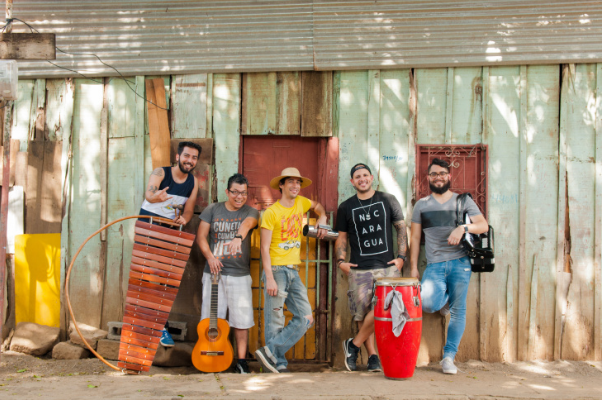La Cuneta digs into its Nicaraguan roots for new album, ‘Cañambuco’


The Nicaraguan band La Cuneta was nominated for a Grammy last year. For the Central American country with a population half the size of L.A. County, this was a big deal. That nomination and all the media attention reinforced the band members’ approach of digging into their country’s roots and culture for a new album.
While in L.A. in May for a performance at the Nicaragua Festival in Huntington Park, three band members gathered for coffee at La Adelita Bakery, a popular hang-out in the heart of L.A.’s Central American community.
The Nicaraguan musicians looked right at home as they talked about the band’s roots. Cuneta means sidewalk in Nicaraguan Spanish. And It was eight years ago, on the streets of Managua, during the city’s patron saint celebration, when La Cuneta was born.
These musicians knew each other, but they were part of other bands. So they decided to create a new group. Drummer Fabio Buitrago said the band started out playing traditional Nicaraguan music:
“But then we decided to mix it up a little bit in the process to include other rhythms and more let’s say contemporary tendencies on the music, so we included rock, funk, ska and new sounds.”
Buitrago said mixing traditional music with contemporary sounds helps young Nicaraguans appreciate the richness of their own culture. And that’s one of the band’s goals, to keep Nicaraguan culture alive.
“Young people do not know about the traditions,” Buitrago said. “Young people are losing the knowledge of where the traditions come from. So what we want to do with this project is just to gather all the music, the tradition, the culture of Nicaragua, give it a fresh update, a fresh sound and new rhythm and then put it back into the people.”
One example of La Cuneta’s re-invention of popular music is one of Nicaragua’s most famous cumbias. Singer Carlos Guillén says they transformed the song with some rock elements and a hip-hop flavor:
“The songs feels a little bit more modern and the sound of course it has synthesizers, electric guitars and things like that. So it is a like a new version of a very folk song called “La Cumbia Chinandegana.”
Greg Landau, who’s produced albums by top Latin acts including Quetzal, Maldita Vecindad, Susana Baca and Jerry Gonzalez, was behind the mixing board for the Grammy-nominated “Mondongo”:
“Mondongo” was more rock and had a lot of electronic elements, tropical rhythms, this was more to explore the Nicaraguan cumbia and to explore new ways to create Nicaraguan rock, celebrating the tradition of Carlos Mejía Godoy who’s also on the record.”
Mejía Godoy is one of Nicaragua’s most respected musical icons. He and his brother, Luis Enrique, provided the soundtrack during the Sandinista Revolution in the late 1970s and early ‘80s. Three of La Cuneta’s band members are part of the Mejia Godoy musical clan. Marimba player Carlos Luis Mejía says his father, Carlos, and uncle, Luis Enrique, dedicated their entire lives working for Nicaragua, its music and culture:
“Since we were little, they have always tell us about the importance about doing this job and tell us the importance of working with dignity, as brothers, with honesty of what we do.”
Landau, who also produced the band’s new album, “Cañambuco,” says La Cuneta’s Grammy nomination acknowledged the Mejia Godoy family and the band’s fresh approach, compared to the other albums in the Latin rock, urban and alternative category:
They kind of push the boundaries of rock en Español, including a lot of indigenous and Nicaraguan folk elements — something that had gotten a little bit lost in that category and was what made Latin rock something unique.
A Grammy nomination can also send a message to the naysayers. Nobody in Nicaragua, or in Latin America for that matter, thought it was possible for a little known band from Managua to get that far.
